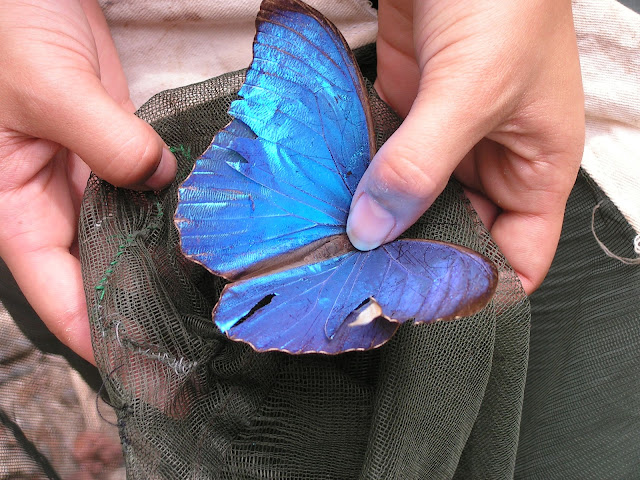 |
| A section of mangrove forest on the Caribbean coast of Panama. |
The shore itself looked like quite the stereotypical tropical paradise:
 |
| The shoreline. |
We were right near the Caribbean opening of the canal which meant that many large ships were in view.
_med.JPG) |
| A ship emerging from the canal. |
Although in some ways they ruined the beautiful natural view, it was interesting to me to see them all about evenly spaced but beginning to turn towards their own routes. Here are just a few, but there about ten ships on the horizon.
_med.JPG) |
| Post-canal ship divergence. |
Don't worry, we also did work. We spent a few hours intensively collecting snail (making sure you've found all the 1-2 cm long snails in a 25 cm square quadrat is rather challenging), and then spent the whole evening dissecting them.
Today was both exciting and unexpected. We thought we were going to a lake to sample more snails to compare with previously sampled snails (specifically, the first day we sampled from a lake with a sport fishing industry that might be affecting the parasite life cycles, so this lake with a commercial fishing industry would serve as a comparison) and were told that we might have some time to look at a bat cave nearby.
So we arrived in an indigenous village and boarded two motorboats in which we were going to cross the lake. The lake itself, Lake Bayano, was very impressive. It's the second largest lake in Panama and man-made. The Bayano River was dammed in 1976 with a hydroelectric dam flooding a 350 square-kilometer region. Interestingly, there are still many drowned trees standing and providing perches for interesting birds (including egrets, multiple species of herons, and ospreys). I was surprised that they were still standing, but was told that the high pressure and anoxic conditions have preserved the wood somehow.
It was wonderful to be out on the water. I love boats, and it was a lot of fun. It was also a painfully slow crossing as our motor kept giving out. The other boat even towed ours to shore so we could switch out motors, but the next one wasn't much better.
There were a few houses where we unloaded, and there was a very sweet (and remarkably sleek and well kept) dog who led the way and was very friendly.
And then we entered the cave. At first we trudged through a little water and admired the rock formations.
 |
| Rock formations near the entrance of the cave. |
And then we got to a point where the water was about neck-high. We placed our packs on the side and removed some layers, and I took off my boots (I had thought cave = hike = boots...well, not so much). And then we embarked on a (barefoot, for me) hike/swim through the bat cave. There were hundreds of bats fluttering about near the ceiling which was, in places, only a few feet above us. There are really no words to describe the cave, it was like something out of a movie. There were definitely some jokes made about Indiana Jones. Anyway, here's the one picture of the cave that I got before leaving my camera behind so it wouldn't get wet.
 |
| The view upward from the cave floor which was covered in flowing water. This was one of the open parts, but much of the cave was covered and very dark. |
_med.JPG)
_med.JPG)



























_med.JPG)










_med.JPG)

_med.JPG)
.jpg)
.jpg)
.jpg)
.jpg)